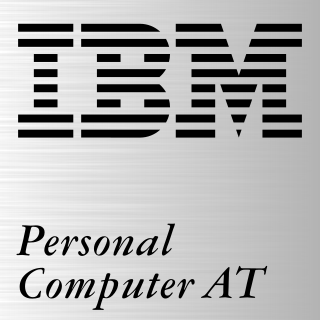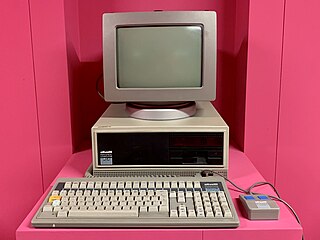Related Research Articles

The Enhanced Graphics Adapter (EGA) is an IBM PC graphics adapter and de facto computer display standard from 1984 that superseded the CGA standard introduced with the original IBM PC, and was itself superseded by the VGA standard in 1987. In addition to the original EGA card manufactured by IBM, many compatible third-party cards were manufactured, and EGA graphics modes continued to be supported by VGA and later standards.

The Personal System/2 or PS/2 is IBM's second generation of personal computers. Released in 1987, it officially replaced the IBM PC, XT, AT, and PC Convertible in IBM's lineup. Many of the PS/2's innovations, such as the 16550 UART, 1440 KB 3.5-inch floppy disk format, 72-pin SIMMs, PS/2 port, and VGA video standard, went on to become standards in the broader PC market.

The IBM Personal Computer AT was released in 1984 as the fourth model in the IBM Personal Computer line, following the IBM PC/XT and its IBM Portable PC variant. It was designed around the Intel 80286 microprocessor.

The Tandy 2000 is a personal computer introduced by Radio Shack in September 1983 based on the 8 MHz Intel 80186 microprocessor running MS-DOS. By comparison, the IBM PC XT used the older 4.77 MHz Intel 8088 processor, and the IBM PC/AT would later use the newer 6 MHz Intel 80286. Due to the 16-bit data bus and more efficient instruction decoding of the 80186, the Tandy 2000 ran significantly faster than other PC compatibles, and slightly faster than the PC AT. The Tandy 2000 was the company's first computer built around an Intel x86 series microprocessor; previous models used the Zilog Z80 and Motorola 6809 CPUs.

The Mindset is an Intel 80186-based MS-DOS personal computer. It was developed by the Mindset Corporation and released in spring 1984. Unlike other IBM PC compatibles of the time, it has custom graphics hardware supporting a 320×200 resolution with 16 simultaneous colors and hardware-accelerated drawing capabilities, including a blitter, allowing it to update the screen 50 times as fast as an IBM standard color graphics adapter. The basic unit was priced at US$1,798. It is conceptually similar to the more successful Amiga released over a year later. Key engineers of both the Amiga and Mindset were ex-Atari, Inc. employees.

The Pivot is a family of early IBM PC–compatible portable computers first released in 1984 by Morrow Designs, a company founded by George Morrow. It was the first lunchbox-style portable computer, with a vertically configured case that has a fold-down keyboard. The only external component is a single AC adapter. It would have been a little top heavy except for the large camcorder-style battery loaded into its base. The Pivot was designed by Chikok Shing of Vadem Inc.

Professional Graphics Controller is a graphics card manufactured by IBM for PCs. It consists of three interconnected PCBs, and contains its own processor and memory. The PGC was, at the time of its release, the most advanced graphics card for the IBM XT and aimed for tasks such as CAD.

The IBM 3270 PC, is a personal computer developed by IBM and released in October 1983. Although its hardware is mostly identical to the IBM PC XT, the 3270 contains additional components that, in combination with software, can emulate the behavior of an IBM 3270 terminal. Therefore, it can be used both as a standalone computer, and as a terminal to a mainframe.
The MBC-550 series, also known as the MBC-550/555, is a series of personal computers sold by Sanyo. It was unveiled at the COMDEX/Spring '83 in April 1983 and first released to market in March 1984. All models in the MBC-550 series featured pizza-box-style cases and Intel 8088 microprocessors and run versions of MS-DOS. On its release in 1984, the MBC-550 was the least expensive IBM PC compatible released to date, at a price of $US$995. The MBC-550 series followed Sanyo's MBC-1000 line of CP/M computers.

The Olivetti M24 is a computer that was sold by Olivetti in 1983 using the Intel 8086 CPU.

The APC was a series of business microcomputers released outside of Japan by the NEC Corporation. The series comprised the APC, the APC II and APC III, international versions of models from the Japanese NEC N5200 series(jp).

The IBM Personal Computer XT is the second computer in the IBM Personal Computer line, released on March 8, 1983. Except for the addition of a built-in hard drive and extra expansion slots, it is very similar to the original IBM PC model 5150 from 1981.

The West PC-800 was a home computer introduced by Norwegian company West Computer AS in 1984. The computer was designed as an alarm center allowing use of several CPUs and operating systems. The company introduced an IBM PC compatible in early 1986 and the West PC-800 line was phased out.

Blue Chip Electronics, Inc., later Blue Chip International, was an American computer company founded by John Rossi in 1982. Founded to develop peripherals for Commodore home computers, the company in 1986 began selling low-cost IBM PC compatibles.

The Personal System/2 Model 30 and Personal System/2 Model 30 286 are IBM's entry-level desktop computers in their Personal System/2 (PS/2) family of personal computers. As opposed to higher-end entries in the PS/2 line which use Micro Channel bus architecture, the Model 30 features an Industry Standard Architecture bus, allowing it to use expansion cards from its direct predecessors, the PC/XT and the PC/AT. The original PS/2 Model 30, released in April 1987, is built upon the Intel 8086 microprocessor clocked at 8 MHz and features the 8-bit ISA bus; the Model 30 286, released in September 1988, features the Intel 80286 clocked at 10 MHz and includes the 16-bit ISA bus.
Quasar Data Products Inc. (QDP), later QDP Computer Systems Inc., was an American computer company based in 1979 in North Olmsted, Ohio, United States. The company was founded by Brian A. Catalucci and Dave L. Kelley, the former a trained engineer who had previously worked as an airline pilot.
The MAD-1 is an IBM PC–compatible desktop computer released by Mad Computers, Inc., of Santa Clara, California, in 1984. The computer was noted among the technology press for its unique, modular design and its 80186 microprocessor, the latter seldom used in PC compatibles. It received positive reviews but sold poorly and was pulled from market a year later.
Terak Corporation was an American computer company based in Scottsdale, Arizona. The company was among the first to market graphical workstations, with their most successful being the Terak 8510/a in 1977. After going public in 1983, the company was acquired by Sanders Associates, who placed it under their CalComp division.

Jonos International, Inc., originally Jonos, Ltd. (JL), later Netcom Research, Inc., was an American computer company active from 1980 to 1992. The company sold a variety of computer hardware products and systems, including STD Bus peripherals, smart terminals, microcomputers, and portable computers. The company's Courier portable computer was the first microcomputer sold with Sony's then-new 3.5-inch floppy disk drives on its release in June 1982. Jonos' systems were widely used in the fields of construction, roadworks, machining, and military.
References
- Chin, Kathy (May 23, 1983). "Pronto Series 16 is a PC look-alike, but also faster". InfoWorld. 5 (21). IDG Publications: 3 – via Google Books.
- Hansen, Skip (June 1983). "The Pronto Series 16". Byte. 8 (6). McGraw-Hill: 168–184 – via the Internet Archive.
- Marshall, Jonathan (January 30, 1984). "New 80186-based micros outpace the IBM PC". InfoWorld. 6 (5). IDG Publications: 59–60 – via Google Books.
- Nadeau, Michael (2002). Collectible Microcomputers. Schiffer Book for Collectors (Illustrated ed.). Schiffer Publishing. ISBN 9780764316005 – via Google Books.
- Ranney, Elizabeth (September 22, 1986). "Company Releases Add-Ons for CAD". InfoWorld. 8 (38). IDG Publications: 19 – via Google Books.
- Staff writer (n.d.). "Pronto Series 16 Personal Computer, Central Processing Unit". National Museum of American History. Smithsonian Institution. Archived from the original on October 29, 2017.
- Staff writer (June 20, 1983b). "Pronto Computers Unwraps Micro Featuring 16-Bit Bus". Computerworld. XVII (25). CW Communications: 69 – via Google Books.
- Staff writer (March 1984a). "Pronto's Solution". Portable Computer. 2 (3). CMP Media: 72 – via the Internet Archive.
- Staff writer (March 28, 1983a). "Expansions". Computerworld. XVII (13). CW Communications: 115 – via Google Books.
- Staff writer (May 21, 1984b). "Pronto Computer Series 16". Computerworld. XVIII (21). CW Communications: 90 – via Google Books.
- Staff writer (October 1983c). "Pronto Series 16 Computer". I.D. 30 (5). F&W Publications: 38 – via the Internet Archive.
- Staff writer (1987). Microcomputer Market Place. Dekotek. ISBN 9780835222679 – via Google Books.
- Warren, Carl (October 1984). "Graphics boards rejuvenate microcomputer displays". Mini-Micro Systems. XVII (12). Cahners Publishing Company: 185–192 – via the Internet Archive.